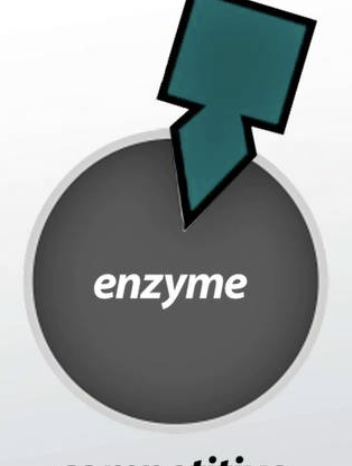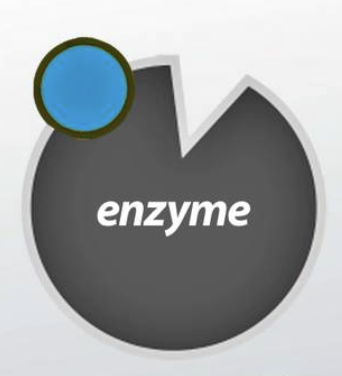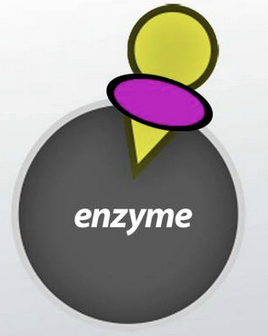Biochemistry Final Exam
1/48
There's no tags or description
Looks like no tags are added yet.
Name | Mastery | Learn | Test | Matching | Spaced |
|---|
No study sessions yet.
49 Terms
What are the types of non covalent interaction?
ionic, hydrogen and van der waals
What are ionic interactions?
between oppositely charged atoms (look for full charges)
What are hydrogen bonds?
due to electronegativity occur between O,N,F
What is the hydrophobic effect?
The tendency of nonpolar substances to aggregate in aqueous solution to minimize their exposure to water, leading to an increase in entropy of the surrounding water molecules.
What is important to know about Gibbs energy?
The lower gibbs energy the more favorable the reaction is
What does delta G naught represent?
Describes the composition of an equilibrium mixture
What is the difference between enthalpy and entropy?
Enthalpy is a measure of the total heat content of a system, while entropy is a measure of the disorder or randomness in a system.
How do ph and pka relate
In terms of panels
if pH < pka, the acid dominates
If pH = pka, acid and base are equal
if pH > pKa, base dominates
What is primary protein sturucture?
Identities and order of amino acids, peptide bonds are known
What is secondary protein stucture?
folded subregions in the back bone
What is a beta strand and an alpha helix ?
Types of secondary protein folding
Beta sheet- H-bonds between peptide backbones
A helix= h bond between 0 of carbonyl “i” and H of amide “i+4)
What is tertiary protein structure?
Entire chain folded on itself
What is Quaternary sturucture?
sturctures formed by 2+ units
What is the final fold in protein folding
when nonpolar gorups on interior to min interactions between them and polar solvent (hydrophobic effect)
What is protein chromatography
Technique deals with small beads in the stationary phase and the mobile phase is anything that can surround or move through the beads
What is size exclusion chromatography
A method that separates proteins based on their size, allowing smaller molecules to elute later than larger ones.
What is cation exchange chromatography
separate proteins based on their net positive charge, where positively charged proteins bind to negatively charged groups on the resin.
What is the equation used for ligand binding?
Kd=[T][L]/[TL]
What do myoglobin and hemoglobin do?
Myoglobin stores O2
hemoglobin transports O2 from the lungs to the tissues
What is important to know about the T vs. R state
The T (tense) state has a lower affinity for oxygen, while the R (relaxed) state has a higher affinity, facilitating oxygen binding and release in hemoglobin.
What is important to know about the regulation of O2 binding
High BPG increases oxygen delivery increasing T state
High pH increases binding affinity increasing R state.
High CO2 increases oxygen delivery, increaseing T state.
How do you calculate the strength of inhibition alpha
alpha = I + [I]/KI
What type of inhibition is this and what substrates are involved and how does it affect km and vmax?

competitive inhibition, involves E, ES, EI, Km increases and vmax stays the same
What type of inhibition is this and what substrates are involved and how does it affect km and vmax

uncompetitive inhibition, involves E, ES, ESI, Km decreases and vmax decreases

What type of inhibition is this and what substrates are involved and how does it affect km and vmax
Non competitive inhibition, involves E, ES, EI, ESI, km stays the same and vmax decreases
What type of molecules cannnot go through a phospholipid bilayer?
Large, polar, or charged molecules
Where does glycolysis and gluconeogensis take places, what two enzymes are the exception?
Both processes occur in the cytosol. Glucose-6-phospatase occurs in the endoplasmic reticulum, pyruvate carboxylase occurs int he mitochondria.
When ATP is high, what two metabolic processes are in effect?
Gluconeogensis and glycogen synthesis
When there is high glucose, what to processes are in effect
glycogen synthesis and glycolysis
What are the beta conformations that the f1 subunit goes through in oxidative phosphorylation?
Open- low affinity for ADP, Pi, and ATP
Loose- high affinity for ADP, Pi
Tight - high affinity for ATP
What is a proton leak?
Loss H+ through pathways other than ATP synthase
What happens in the fed state in the liver, fat, brain, and muscle ?
Liver: uptake in glucose use and storage, uptake in fatty acid uptake storage and synthesis
Fatty acids: uptake storage and use
Brain: glucose uptake and use
Muscle: uptake and strage of glucose and fatty acids
What happens in the fasted stated in the liver, fat, brain and muscle?
Liver: export and synthesize glucose and release from storage. Fatty acids are used and released from storage
Fat: fatty acids are used released from storage and export
Brain: Uptake and use of glucose and ketones.
What happens in the rested state in liver, fat, brain, and muscle
Liver: fatty acids are used
Fat: fatty acids are going through uptake, storage and use
Brain: uptake and use of glucose
Muscle: uptake and storage of glucose. Uptake and release from storage of fatty acids.
What happens in the exercise state in the liver, fat, brain, and muscle
Liver: export release from storage and synthesis of glucose. Use release from storage of fatty acids.
Fat: use release from storage and export of fatty acids.
Brain: uptake and use of glucose and ketones
Muscle: Uptake release from storage and use of both fatty acids and glucose.
What is the difference between white and brown fat cells?
White fat cells store energy and provide insulation, while brown fat cells generate heat through thermogenesis.
What is ketogenesis and where does it occur?
Synthesis of ketone bodies (acetyl-coa → Ketones), occurs in mitochondrial matrix of liver cells
What is ketosis?
Normal physiological state of ketone bodies
What is ketoacidosis?
too man ketones which lowers blood ph
How are too many ketones synthesized by?
extended fasting, proglonged excercise, low carb diet, type 1 diabetes, low OAA levels
How does excercise alter metabolism?
Increased glucose uptake, glyolcysis, glycogen storage capacity, fatty acid breakdown, # of mitochondria, and oxidative phosphorylation
What is cancer and what does it do to metabolic pathways?
Uncontrolled division of abnormal cells
Promotes glucose uptake and fermentation and altered fatty acid metabolism
What is the process of fatty acid breakdown? what are the net substrates and products ?
Fatty acid + CoA becomes acyl coa. Acyl coa becomes acyl carnitine and gets transported into the mitochondrial matrix. B oxidation and every round removes 2 carbons of acetyl-COa which also makes NADH and FADH2.
What is the process of fatty acid synthesis and what are the products and substrates.
Acetyl-CoA converts to citrate and crosses into the cytosol and back to Acetyl-CoA. Then it combines with malonyl coa and adds two carbons to creat a fatty acid chain. The carrier molecule is Acyl-ACP and holds the growing chain.
What is a glycosidic bond?
Any bond between a sugar and another molecule
How do protons stabilize the T state?
Lowers the pH making it more T like
How does kcat and km relate to serine proteases
Kcat is more dependent on oxyanion hole while specificity pocket influences kM.
What is the cori cycle?
The Cori cycle is a metabolic pathway in which lactate produced by anaerobic glycolysis in muscles is transported to the liver and converted back to glucose.